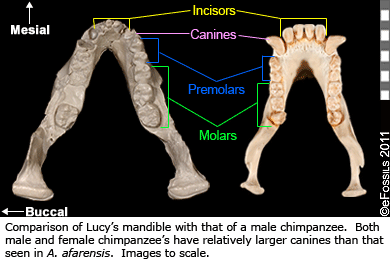 Lucy probably ate a mix of foods, including ripe fruits, nuts, and tubers from both the forest and savanna. Incisor teeth are typically used to prepare the food for mastication (think about biting off a piece of an apple), and molar teeth are used to masticate, or chew, the food into a small pulp that can be swallowed. Compared to chimpanzees, Lucy had relatively smaller incisor teeth, but larger molar teeth, suggesting that she did little to dentally prepare her food, and spent more time intensively chewing or breaking down the food6.
Lucy probably ate a mix of foods, including ripe fruits, nuts, and tubers from both the forest and savanna. Incisor teeth are typically used to prepare the food for mastication (think about biting off a piece of an apple), and molar teeth are used to masticate, or chew, the food into a small pulp that can be swallowed. Compared to chimpanzees, Lucy had relatively smaller incisor teeth, but larger molar teeth, suggesting that she did little to dentally prepare her food, and spent more time intensively chewing or breaking down the food6.
Additionally, the enamel or hard outer shell of the tooth, and the body of the mandible itself, were relatively thicker in Lucy than chimpanzees, affording greater strength for the mastication of tough or hard-object foods. Foods that require a lot of chewing include nuts, seeds, and underground storage organs (root vegetables). However, A. afarensis incisors also show patterns of wear consistent with stripping leaves, and the canines show patterns of wear consistent with puncturing or crushing foods7. Thus, Lucy probably also ate ripe fruits when they were seasonally available.
eFossils is a collaborative website in which users can explore important fossil localities and browse the fossil digital library. If you have any problems using this site or have any other questions, please feel free to contact us.
Funding for eFossils was provided by the Longhorn Innovation Fund for Technology (LIFT) Award from the Research & Educational Technology Committee (R&E) of the IT governance structure at The University of Texas at Austin.
